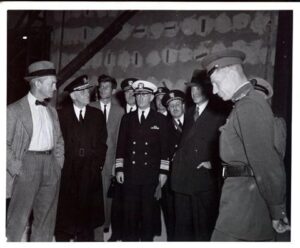Staff Pick: Robert L. Ghormley Papers

Image Source: Robert L. Ghormley Papers (#1153), East Carolina Manuscript Collection, J. Y. Joyner Library, East Carolina University, Greenville, North Carolina, USA.
The photograph to the right is one of 13 images in a file documenting the operations of the American – British – Soviet Tripartite Naval Commission, which the World War II allies established during the Potsdam Conference of July 16 – August 2, 1945. The Commission’s goal was to inventory the remaining assets of the German Navy and to decide how to dispose of them. The hope was that it would help prolong the allies’ wartime unity. In the undated photograph, Admiral Ghormley is seen standing second from the left speaking with members of the Commission either before or after one of their meetings.
The file is part of the Robert L. Ghormley Papers (#1153), which documents his long, and mostly illustrious, naval career. During his career, Vice Admiral Ghormley served in China, Nicaragua, World War I, and Haiti from 1906 – 1918. Between the world wars, he served three tours at the Navy Department, attended the Naval War College, and also served as commander of the destroyer USS SANDS and the battleship USS NEVADA. During World War II, Ghormley served in the following capacities: President Franklin D. Roosevelt’s Special Naval Observer in Europe from August 1940-April 1942; Allied Theater Commander of the South Pacific Area and South Pacific Force during the battles for Guadalcanal and the Solomon Islands from April-October 1942; Commander of the Fourteenth Naval District and the Hawaiian Sea Frontier from 1943-1944; Commander of United States Naval Forces in Europe from November 1944 – December 1945.
As Commander of all U. S. Naval forces in Europe, Ghormley attended the Potsdam Conference, and was the senior American representative on the Tripartite Naval Commission from early August 1945 until he left Germany on December 20th, 1945. His departure came shortly after the Commission made its report and shortly before his own retirement from the Navy.
The Commission managed to inventory most the extant German Naval assets, but failed to complete the inventory due to the chaotic conditions in Europe at the time. Even so, the greatest difficulty proved to be the allies’ inability to reach an agreement on how to dispose of their wartime booty. This was one of the earliest signs that wartime unity among the allies was fading rapidly, in the wake of Germany’s defeat, and that conditions for a new Cold War were growing stronger.
Sometime after Ghormley retired from the Navy, in early 1946, he loaned the previously mentioned 13 images to the Navy for use in a Saturday Evening Post article that documented the work of the Tripartite Commission. Afterwards, between May 1948 and June 1949, the Navy filed or released the images and added Ghormley’s photographs to its official records. On March 29th, 1949, the Navy’s Pictorial Section, Office of Public Relations, Department of the Navy, returned the photographs to Ghormley and thanked him for letting them use the images “in connection with an article in the Saturday Evening Post.” The Navy also wrote that: “We deeply appreciate your generosity in making these photographs available to us, inasmuch as it helped us to include pertinent data in our files concerning the tripartite Naval commission.”
Considering the Navy did not identify anyone in the photograph above, some questions remain. Who is that young man in civilian dress standing, third from the left, behind Admiral Ghormley’s left shoulder? Could it be a 28-year-old future President John F. Kennedy, recently discharged from the Navy due to his wartime injuries and soon to campaign successfully for election to the House of Representatives from Massachusetts? Or is the image of someone other than JFK? If so, who was it? What do you think? Please let us know your thoughts.
Source: Robert L. Ghormley Papers (#1153), East Carolina Manuscript Collection, J. Y. Joyner Library, East Carolina University, Greenville, North Carolina, USA.